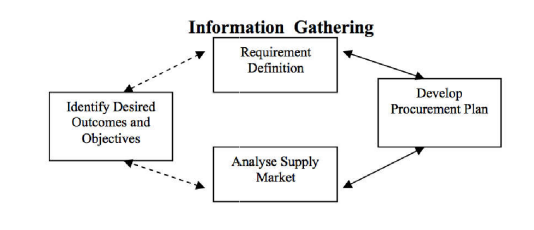Once a requisition or project plan is received determining an actual requirement, the procurement officer is then responsible for developing the individual procurement plan. The scope of the individual procurement plan will depend on the complexity of the requirement. While it is good practice to always make a plan, in the case of low risk/low spend requirements the plan should be simple, but should include an overview of the necessary steps of the process and associated timeline. At the other end of the scale, managing the procurement of an extremely high risk/high spend requirement is in fact project management and should entail a thorough and comprehensive planning process.
Responsibility
It is the responsibility of the procurement officer to ensure that an appropriate level of procurement planning is conducted depending on the particular requirement.
Significant purchases
Particular focus needs to be made in developing plans for ―significant purchases‖. Significant purchases are those goods, services of works that have been identified as being of high relative expenditure and/or are difficult to secure. An example of a significant purchase could be one annual purchase valued at USD 1 million, such as a complex consulting assignment. Alternatively it could be a large number of low value purchases within one year, which could be more economically addressed through an LTA.
Process
The diagram below shows each of the stages in the individual procurement planning process.

Identification of desired procurement outcomes and objectives
The first step in the planning process is to identify the desired outcomes and objectives of the procurement. However the process is not necessarily linear. In some cases information obtained in the informational gathering stage will also have an impact on the identification of objectives. For example, an analysis of the supply market shows that there are limited sources of supply which means that a key objective is to identify suppliers who can develop alternative products. This, in turn, will have an impact on the requirement definition stage of the process.
The complexity of this process will vary from case to case. In some instances, for example where the requirement is for a commodity used across the organization with high volume, e.g. vehicles, the objectives and the desired outcomes of the procurement action may already be clearly defined in the organization‘s procurement strategy. In other instances, such as the procurement of a complex and high value solution that is critical to the organization or the client, then there may be a complex network of stakeholders each with their own ideas of objectives and desired outcomes.
Stakeholders
Where the situation is complex it can be a good idea to systematically analyse the stakeholders involved. Stakeholders are anyone who has an interest in procurement activities delivering actual or perceived objectives. They can include development partners, clients, end-users, civil society, senior management, finance, technical experts, etc. It is important to identify the interests and relative importance of each stakeholder. Sometimes the interests of various stakeholders can be in conflict or competition with each other. In practice the procurement officer usually needs to develop a collaborative, but focused relationship with key stakeholders.
This includes listening to their concerns and ideas, seeking their agreement where necessary, keeping them informed, challenging their needs and wants, and adapting to their needs where necessary. Nevertheless, in this process, the procurement officer at the same time needs to represent and defend the interest of the UN organization within its regulative and procedural framework.
Specific objectives of key stakeholders may relate to:
- delivery times
- adherence to specific regulatory frameworks
- sourcing from specific groups of suppliers
- use of specific brands, if justified.
These stakeholder objectives need to be combined with the information gathered during the requirement specification and supply market analysis and the organization‘s overall procurement strategy. Then, if necessary through a collaborative process, the objectives and outcomes for the procurement should be agreed. At this time performance measures and indicators should also be agreed which will enable the procurement officer to determine whether the agreed procurement objectives have been met.
Information gathering
The Information gathering stage relates to collecting and analysing two types of information:
- definition of requirement
- analysis of the supply market.
The information gathered in both cases will provide input into the identification of the objectives and outcomes and development of the procurement plan.
Development of the procurement plan
Once the objectives have been set and the relevant information on the requirement definition and the supply market has been gathered the next stage is to develop the ―procurement plan‖. A key element of this is selection of the procurement method.
Once the procurement method has been selected the procurement plan can be elaborated, often in collaboration with key stakeholders such as the client, requisitioner or technical experts.
Typically the procurement plan would include the following information:
- procurement objectives and performance indicators
- breakdown of activities in accordance with the selected procurement method
- identification of responsible party for each activity
- timeline and milestones taking into consideration procurement method and required clearances
- all appropriate administrative requirements (relevant codes, budget allotments, etc.).
